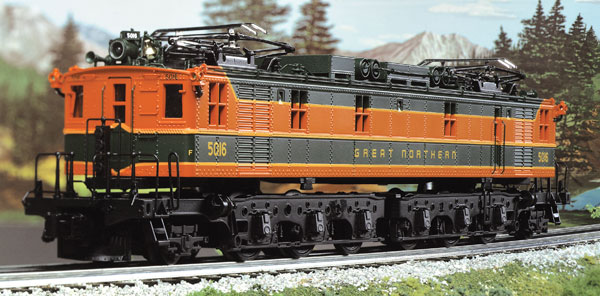The grades of Washington state’s Cascade Mountains were a tough nut to crack for the Great Northern. The first Cascade Tunnel was built in 1900. At an elevation of 3,400 feet, it had 1.7 and 2.2 percent grades leading up to the tunnel entrances. Steam locomotive crews running through the tunnel faced asphyxiation due to dangerous gases trapped in the tunnel.
In 1909 the Great Northern ordered its first electric locomotive to service the tunnel. Eventually, the electrified zone around the tunnel came to be more than 70 miles long, and the railroad increased the size of its electric engine fleet accordingly.
Between 1927 and 1930 General Electric built eight Y1 class locomotives for the Great Northern. If a train went through the Cascades it was probably pulled by a Y1.
The locomotives performed well, but in balancing the economics of retaining and expanding the electrified zone or dieselizing the route, the railroad went with diesels. All the Y1s were retired in 1956 and sold to the Pennsylvania. The Pennsy, in turn, sold no. 5018 to the Union Pacific, and the rest were retired in the late 1960s.
The model
Like all the large, MTH Premier line electrics, this model is a heavy metal monster. The die-cast metal model weighs in at 9 pounds. Coupler-to-coupler, it measures 19 inches (76 feet in length) which includes the oversized O gauge couplers. The real locomotive’s length was 73 feet, 9 inches.
There aren’t a lot of graceful lines on the Y1. Face it, these locomotives aren’t called “box cabs” for nothing.
The body shell tooling is well executed and I noticed no flaws in our sample locomotive. As you might expect, there are more rivets cast into the shell than I cared to count. All of the add-ons, such as grab irons, lift rings, compressors, and equipment boxes, enhance the long body shell. The headlights have illuminated number boards, and the pantographs, the jewel in the crown of any electric, are well executed.
If there is a down side to the authentic look of the locomotive, it is the heads of the four Phillips screws used to affix the marker lights to the sides of the cab. But then you’ll find the same sort of thing on steam locomotives of many brands.
In both fore and aft cabs you’ll find an engineer figure and an empty seat for the fireman. There are control panels in the cabs but the only time I could see them was after I had removed the locomotive’s body shell. I was a bit surprised that only the front and rear cab doors actually opened; the doors on either flank are simply cast in.
The decks are nice, with a tread pattern on the upper section. There are handrails galore, and a very nice stand for making multiple unit connections.
Paint application was generally good, especially on the tricky roof of the cab.
On the test track
Performance numbers were very good. In conventional-control mode we clocked the low-end speed at 5.7 scale mph, thanks to the ProtoSound 2.0 speed-control circuitry. The high-end speed average was 79.1. Drawbar pull for the locomotive was 3 pounds, 7 ounces.
We only noted one odd thing during testing. When the locomotive was moving, the front and rear couplers continuously nodded up and down, altering their position about 1/4 of an inch. This was the same on straight or curved track. However, it did not cause any of our test trains to uncouple.
While designed for O-72 operation, we were able to coax our sample Y1 through some O-54 tubular track curves, but we don’t recommend it.
All of the Digital Command System features worked as expected, and the MTH cruise control is the best (and most frustration free) I’ve used.
I’m not a fan of the sound systems of electric locomotives. It’s not the sound systems themselves, but electric locomotives to me are as exciting to listen to as white noise.
The Y1’s sound package reminded me of a power plant, with generators climbing up and down the rpm scale. Overall, it’s not completely bad sounding, but it just lacks the punch of a diesel or steam sound package.
The Y1 is a pleasing addition to the Premier line’s hall of electric motive power. MTH’s model delivers first-rate performance. Fans of electric locomotives in general, or Great Northern power in particular, will want to take a close look at this locomotive.














